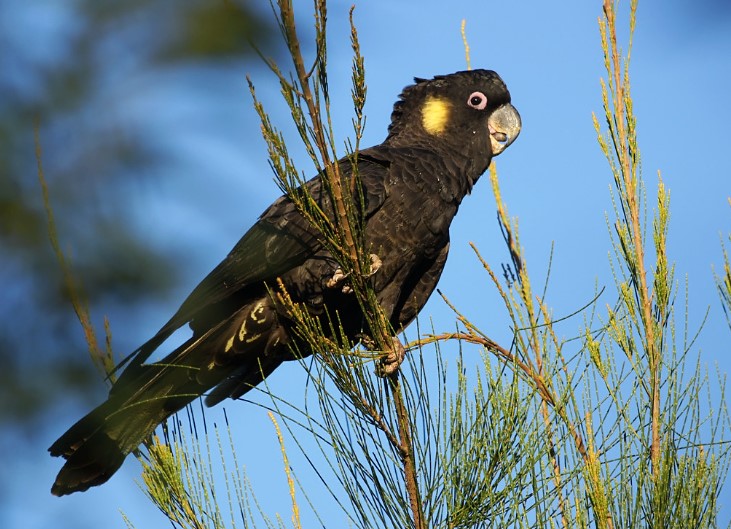In the eucalypt forests and pine plantations of Southeast Australia, yellow-tailed black cockatoos call with long-carrying wailing cries as they fly slowly over the trees. In search of food, the flocks migrate between the coast and adjacent ranges, eating seeds of conifers, banksias, hakes, and wood-boring larvae of eucalypts and acacias, taking in trees and shrubs. Its bills are narrow and pointed, and it is well suited for biting into pine cones and banksia cones.
The upper mandible pierces and hooks in, while the lower mandible slices through with a powerful pincer motion. The larger race, which occurs in small family groups of up to 20 on the east coast south to Gippsland, consumes seeds as well as insect larvae. Other species in Tasmania, western Victoria, and South Australia eat seeds exclusively, often congregating in flocks of up to a hundred to feed on radiata pine plantations.

Nests are built in tree hollows high in the trees. When the first egg is laid, the female begins incubation and sits for the four weeks it takes for hatchlings to emerge. During this time, the male provides the food. In the case of the white-tailed species, only one chick survives. Both parents feed the nestlings until they fledge in about three months, but they don’t become independent until just before the following breeding season.
Among its other names are Funereal Cockatoo, Yellow-eared Black Cockatoo, and Wylah. Similar to the White-tailed Black Cockatoo, the yellow-tailed black cockatoo calls with a drawn-out whistle. In alarm, it is also a single-syllable harsh call. Harsh rasps are heard from fledglings.
Yellow-tailed Black-Cockatoos are about 550–650 mm long, with long tapered tails about half the length of the body. Feathers on underparts often have a wider yellow edge than feathers on upperparts.
MALE: Body plumage is dusky black with yellow-edged feathers. There is a small yellow patch on the cheek. There is a dusky color on the wings, a broad band of yellow near the tail end, speckled with dark brown, and black feathers in the center of the tail. The eyes are dark brown with a pink ring around them. There is a very dark gray color to the bill. Grey-brown feet and toes, and dusky claws.
The cheek patches of female birds are larger and brighter yellow; the skin surrounding the eye is dark grey. The bill is bone-colored. The feet and toes are buff-olive in color. Immature birds are similar to adult females. Like adult males, young males may have a small, dull yellow cheek patch. Downy young are long and yellow-downed.
Often heard before seen, yellow-tailed black cockatoos are diurnal, raucous, and noisy. Often seen flying high overhead in pairs, or trios consisting of a pair and their young, or small groups, they make long journeys by flying at a considerable height while calling to each other. In the north, nesting occurs from March to August; in the south, it occurs from July to January.
A nest is a hollow embedded very high in a tree. The entrance is 180 mm wide, and the floor is twice that size. Two eggs, white, oval, 45–50 x 37 mm each. The female incubates the egg for four weeks. In about three months, the young fledged Due to its gloomy and dark plumage, the English naturalist George Shaw gave the yellow-tailed black cockatoo the name Psittacus funereus in 1794.
In eucalypt forests, heaths, and pine plantations, Yellow-tailed Black-Cockatoos are found in coastal eastern Australia and adjacent ranges north of Emerald, Qld, west to Eyre Peninsula and Kangaroo Island, SA, and south to Tasmania. Two races exist.







